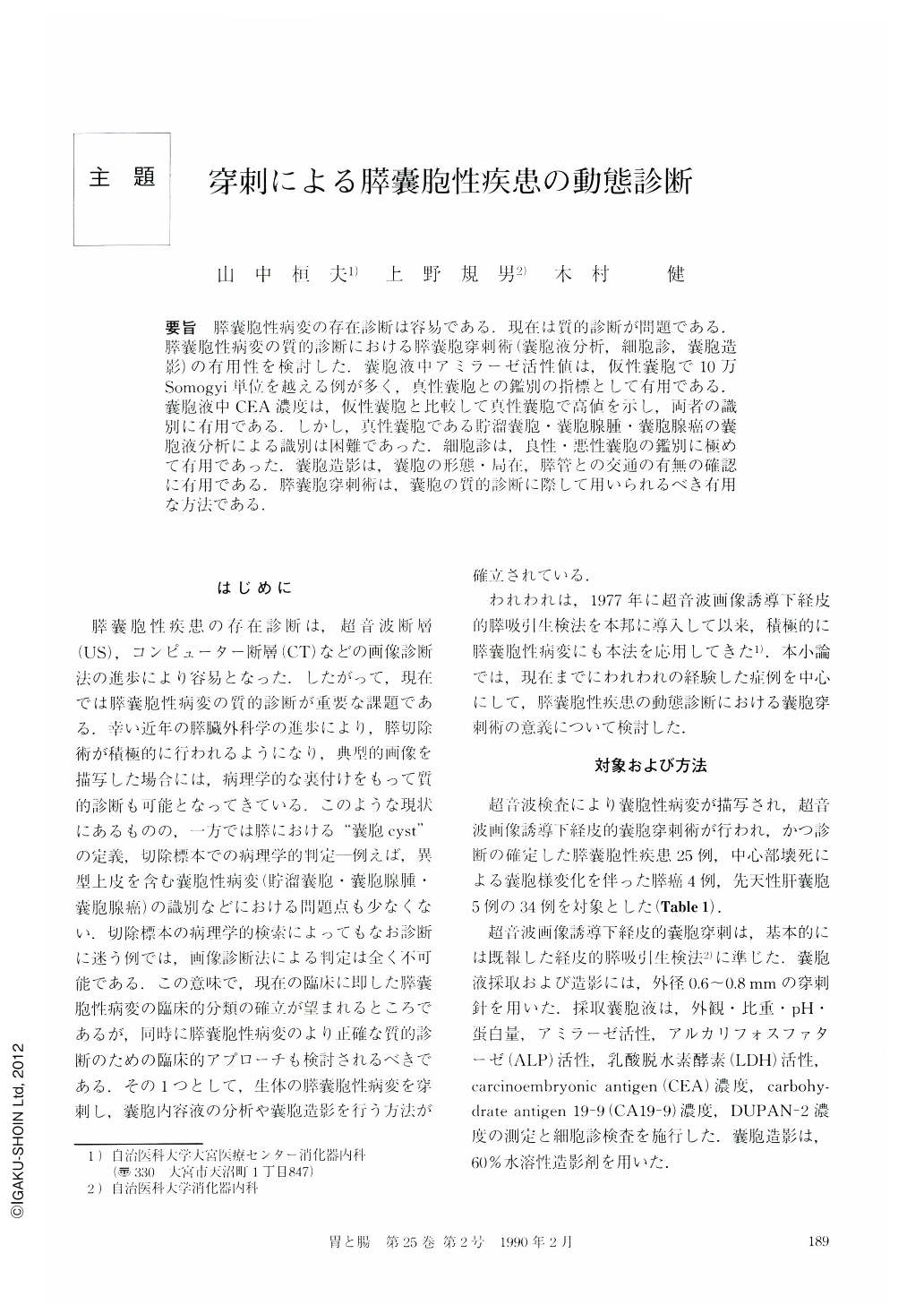Japanese
English
- 有料閲覧
- Abstract 文献概要
- 1ページ目 Look Inside
要旨 膵囊胞性病変の存在診断は容易である.現在は質的診断が問題である.膵囊胞性病変の質的診断における膵囊胞穿刺術(囊胞液分析,細胞診,囊胞造影)の有用性を検討した.囊胞液中アミラーゼ活性値は,仮性囊胞で10万Somogyi単位を越える例が多く,真性囊胞との鑑別の指標として有用である.囊胞液中CEA濃度は,仮性囊胞と比較して真性囊胞で高値を示し,両者の識別に有用である.しかし,真性囊胞である貯溜囊胞・囊胞腺腫・囊胞腺癌の囊胞液分析による識別は困難であった.細胞診は,良性・悪性囊胞の鑑別に極めて有用であった.囊胞造影は,囊胞の形態・局在,膵管との交通の有無の確認に有用である.膵囊胞穿刺術は,囊胞の質的診断に際して用いられるべき有用な方法である.
Ultrasonically guided percutaneous puncture was performed on 29 patients with pancreatic cystic lesion and 5 patients with liver cyst. The final diagnoses confirmed by clinical findings, exploratory laparotomy and/or autopsy were pancreatic pseudocyst in 12 cases (postinflammatory 11, post-traumatic 1), pancreatic retention cyst in 5 cases, pancreatic cystadenoma in 2 cases, pancreatic cystadenocarcinoma in 6 cases, pancreatic solid adenocarcinoma with central necrosis in 4 cases and congenital liver cyst in 5 cases.
The clinical purposes of the procedure are for (1) biochemical, bacteriological and cytological examinations of aspirated fluid from the cyst, (2) roentgenographic visualization of the cyst by direct injection of contrast medium, and (3) complete aspiration of the fluid from the cyst as a therapeutic treatment. We report here the results of our study on biochemical and cytological examinations of cystic fluid, and roentgenographic visualization of the cysts.
(1) Examinations of aspirated fluid from the cysts. The aspirated fluid proved to be fairly diagnostic. In pseudocysts, the concentration of amylase in the aspirated fluid was very high, compared with that in other cystic lesions. This finding was very useful in distinguishing pseudocyst from true cysts.
The concentrations of carcinoembryonic antigen (CEA) and carbohydrate antigen 19-9 (CA 19-9) were high in the fluid of true cysts (retention cyst, cystadenoma, cystadenocarcinoma), compared with that in the fluid of pseudocyst.
Results of cytological examinations were as follows, as was expected: Class Ⅰ in all cases of benign cysts (pseudocyst, retention cyst, cystadenoma, congenital liver cyst), Class Ⅲ in 2 of 6 cases with cystadenocarcinoma, and Class Ⅴ in 6 of 8 cases with malignant cysts (cystadenocarcinoma, solid adenocarcinoma). Thus the cytological examination of cystic fluid was useful in distinguishing benign cyst and malignant cyst.
(2) Roentgenographic visualization of the cysts. This method may be very useful in clearly demonstrating outline and location of the cysts.
Because of its safety, easiness and diagnostic reliability, the procedure is expected to be applied more widely and frequently in the differential diagnosis of cystic diseases of the pancreas.

Copyright © 1990, Igaku-Shoin Ltd. All rights reserved.


